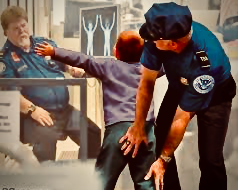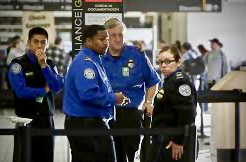FEDERAL OFFENSES. TSA: Taking a Ruler to the ‘Unrulies’.
Federal Offenses: T.S.A., D.O.T., F.A.A., N.T.S.B. (Premise).
9/3/21—Watch out, Vamigrés! Better line up, shut up, straighten up and fly just right. Or risk taking a number: 95, to be exact.
Because the Transportation Security Agency has quietly instituted its next-gen watchlist. This newly invasive iteration comprises those travelers who may be taking, joking, jockeying and otherwise ‘misbehaving’ through airport checkpoints. And the TSAsers call it the 95 list.
In force since February, the TSA has been compiling a log of travelers/tourist whose attitudes or specific  actions pose a physical and/or psychological threat to its Transportation Security Officers (screeners to us). Now tracked is in-line contact that is deemed out of line (i.e., “offensive and without legal justification”)—amid an “alarming spike” in troubling checkpoint incidents.
actions pose a physical and/or psychological threat to its Transportation Security Officers (screeners to us). Now tracked is in-line contact that is deemed out of line (i.e., “offensive and without legal justification”)—amid an “alarming spike” in troubling checkpoint incidents.
According to their latest directive, “an intent to injurer or cause physical pain is not required, nor is actual physical injury.” So, no more lurking, no loitering (or lusting, for that matter)—any rudeness or hi-jinx that “challenges the safe, effective completion of screening.” Nevertheless, the 95 cannot keep passengers from their flights or trigger undue secondary screening.
TSA honchos say their latest list intends to protect already stressed screeners/TSOs from T/Ts who have been unruly, let alone “exhibiting disruptive or assaultive behavior in and around checkpoints in the past. They cite some 34 assaults on screeners in 2017, up significantly from the year before, while issuing guidelines that prohibit listing or profiling passengers based solely on race, gender or religion. Reportedly, at least 50 names have been 95ed thus far, including for mere verbal dust-ups, with this list growing by the day.
Feeling the need?
But really, do we need yet another open-ended watchlist? For the TSA already maintains watch and/or no-fly databases of well over one million persons considered potential threats to government officials and facilities, if not suspected terrorists plotting against the U.S..
Yet how many of those people listed are mistakenly I.D.ed and pose no genuine threat to airports or  planes? And if wrongfully listed/profiled, how do individuals contest or seek removal of their names? Indeed, once onboard the U.S. homeland security system, there appears to be no effective off-ramp.
planes? And if wrongfully listed/profiled, how do individuals contest or seek removal of their names? Indeed, once onboard the U.S. homeland security system, there appears to be no effective off-ramp.
Only top TSA officials and certain Air Marshals can add/remove names from their databases, 95 included. And they do not detail how people can appeal being listed at all. This, when upwards of 35% of listed names overall are in fact outdated or questionably evidenced from the outset.
Furthermore, 95 listing can only lengthen, slow or stall already overburdensome TSA checkpoint strip searches and shakedowns. Small price to pay, it seems, in the service of sparing their sensitive little TSO/screener souls.
Feeling the Squeeze.
Thus we can clam up, peel down, tidy our screening trays, spread ’em and no swatting away of too touchy-feely hands. No lip, no attitude, no gestures, no drama whatsoever—no joke. And forget about frisky fashion statements or feisty sweatshirts and Tees, much less a full singular salute.
Or we Vamigrés can call out the TSA excesses and strike a blow for traveler rights and respectfulness by steely smiling our way through the security labyrinth, taking names and badge numbers of any TSO overreach and abuses, for an developing database of our own. Call it watching the watchers: Anything to get screeners to better focus on their more essential mission: catching the creeps, weaponry and contraband that continue to slip onboard…
Still, these TSA screening procedures, whether gratuitous or benign, become all the more ripe for scrutiny—most recently, the CT scans to expedite the screening of carry-on luggage. Particularly now that the Third Circuit of the U.S. Court of Appeals has ruled that checkpoint screeners are federal administrative employees rather than law enforcement officers.
This 2-to-1 ruling means TSA security agents are not liable for being sued in civil cases resulting from shakedown/strip searches, microbe/germ-blighted security trays or other misconduct, intentional or otherwise.
A Probing Reality?
The slim court majority determined that TSA screening is a necessary reality of flying today, including searches of passengers’ persons and belongings, since Congress has limited such liability to actual law enforcement officers. 
So TSA screeners can apparently feel free to push the red lines of overzealousness and aggression as they conduct their searches—at least when it comes to potential civil suits. The dissenting judge acknowledged that their ruling “precludes victims of TSA abuses from obtaining any meaningful remedy” should we feel we’ve been treated unfairly.
Or The Utter Contempt Of Courts?
Screener immunity and impunity may not extend to criminal liability, and agents can still be open to disciplinary action within the TSA over passenger filed complaints. But who’s actually paying any price or attention there?
While the courts are making it more and more difficult to seek redress, for constitutional violations on down.
And although this appeals court decision applies primarily to screener cases in Pennsylvania, Delaware and New Jersey, it establishes an anti-passenger precedent for TSA agent immunity throughout the U.S.
Quieter Skies or Marshal Law?
Yet now come reports of Federal Air Marshal excess to an alarming degree. Since back in 2010, the TSA has apparently been assigning its Air Marshals to ‘observe rather than monitor’ U.S. travelers not on terrorist watch lists, under investigation nor suspected of any crimes at all. That is, essentially quantifying ordinary ticks and traits through close scrutiny and algorithmic profiling (though not by race or religion, so they claim).
Whether on in-or-outbound domestic flights, or simply moving about airports, we can be subject to ‘robust’ TSA surveillance or ‘obsessive observation’ as to our ‘travel patterns’, such as eating, sleeping, fidgeting, blinking, chattering, swearing, sweating, entertaining ourselves (electronically, digitally, of course) or displaying cold, penetrating stares that may raise suspicions.
 Not to gather information, says TSA, but solely to protects passengers and flight crews. They call their Quiet Skies program ‘maximizing use’ of the marshals, an additional (budget busting) line of defense for aviation security—ostensibly to keep another terror act from striking at 30,000 feet. As if trailing travelers in airports is the best use of agency resources.
Not to gather information, says TSA, but solely to protects passengers and flight crews. They call their Quiet Skies program ‘maximizing use’ of the marshals, an additional (budget busting) line of defense for aviation security—ostensibly to keep another terror act from striking at 30,000 feet. As if trailing travelers in airports is the best use of agency resources.
But excessive observation, even following the U.S. traveling public without warrants or probable cause poses Constitutional questions, to say the least. Again, we’re considered guilty before proving our innocence?
Given still more Federal overreach in the skies here, what to make of invasive new facial-recognition procedures (such as now being introduced at San Jose, California’s Mineta Airport)? Indeed, how can we possibly remain so pliantly nice and quiet?
Which means the TSA-traveler ‘tug of war’ is getting all the knottier, and Vamigré is fixing to pull more firmly on our end. More to come…
